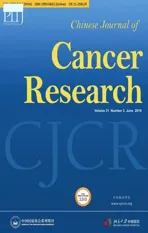Management guidelines for primary lung cancer 2018: Chinese standards in clinical practice
2019-02-17ChaoLyuNanWu
Chao Lyu, Nan Wu
Chinese guidelines for diagnosis and treatment of primary lung cancer 2018 are a set of clinical standards for screening, diagnosis and treatment of lung cancer in China(1). It covers the specialties of epidemiology, radiology,pathology, surgery, medical oncology, radiotherapy,endoscopy, nuclear medicine, and so on. The guidelines are referred to by physicians, medical students and patients,through providing comprehensive and detailed knowledge and recommendations in clinical practice on lung cancer diagnosis and treatment.
The guidelines are featured by its design and contents.First, it highlights the clinical symptoms related to lung cancer, physical examination, laboratory examinations and radiographic characteristics of lung cancer. This is different from that of National Comprehensive Cancer Network(NCCN) guidelines in the US., which have typical algorithms or flowcharts for clinical decision-making process according to different stages of lung cancer.Actually, these contents are established on the basis of clinical experience, similar to the textbook of lung cancer,in which the radiography is especially described in detail,including the differential diagnosis of various benign and malignant lesions of the lung. In surgical treatment section,surgical anatomy of bronchi and lung system is introduced in detail. This section focuses on surgical indications,contraindications and quality control of surgery, as well as general surgical procedures of lung cancer, lobectomy in particular. The diagnosis and treatment of postoperative complication was also mentioned, which makes the guidelines more practical in the management of patients underwent lung cancer surgery. In the part of pathology,the management of specimen is of importance, so are the methods of immunohistochemistry, special staining and pathological molecular testing. We need criteria to standardize the procedure of specimen collection,processing, pathological diagnosis and report, which have been presented comprehensively in the guidelines. At the same time, the guidelines also refer to other contemporary clinical practice guidelines such as NCCN and American College of Chest Physicians (ACCP), as well as the opinion of domestic experts in lung cancer, in the issue of lung cancer screening, the application of positron emission tomography-computed tomography (PET/CT), lung cancer staging and prognosis, so as to make this guidelines more reliable and keep current.
As a professional standard guideline of management for lung cancer in China, the guidelines also include many diagnostic and therapeutic methods with Chinese characteristics. For example, concurrent chemoradiation is recommended in NCCN guidelines for stage IIIA N2 lung cancer, whereas surgery is only 2B evidence. But in China,based on multidisciplinary treatment (MDT) discussions,multiple modalities dominated by surgery are commonly used. Currently, for the staging evaluation before treatment, PET/CT and bronchoscopy have been involved as routine examinations for lung cancer patients in NCCN,whereas mediastinoscopy, endobronchial ultrasoundtransbronchial needle aspiration biopsy (EBUS-TBNA)and esophageal ultrasound (EUS) are used as mediastinal lymph node evaluation methods, except solid tumor <1 cm or purely non-solid tumors <3 cm. In European Society of Thoracic Surgeons (ESTS) guidelines, PET/CT is recommended for staging evaluation, while for N2 negative disease, cN1 or central diseases or tumor >3 cm are indications for pre-resection pathologic mediastinal evaluation. According to the clinical practice in China,invasive mediastinal staging examination is not mandatory and considered as an option in qualified hospitals, if the complete resection could be guaranteed by thoracic surgeon’s evaluation. This treatment modality is more feasible under current domestic situation to avoid unnecessary invasive examinations. In neoadjuvant therapy,Chinese experience recommends two cycles of neoadjuvant chemotherapy in combination with two cycles of adjuvant chemotherapy, which is different from 3-4 cycles of preoperative chemotherapy in most of the other countries.This treatment modality has the advantages of evaluating the effect of chemotherapy in time, while avoiding delayed surgery and surgical complications resulting from treatment toxicity. Postoperative adjuvant chemotherapy should be determined by preoperative staging, efficacy of neoadjuvant therapy and patient’s tolerance, to decide whether to continue the preoperative regimen or switch to other regimens. In addition, the guidelines also involve the use of Endostatin and Anlotinib, local treatment by bronchoscopic interventional therapy, palliative treatment for advanced lung cancer and so on, which have been proved to be effective by Chinese clinical practice.
It should be pointed out that there are also some limitations in the guidelines. First, the treatment of lung cancer, especially the medical treatment, updates frequently, so the guideline still needs to revise continuously and provide recommendations based on the best published evidence available, in order to reflect the latest data and clinical information in clinical practice standards. Second, as a guideline in surgical management of lung cancer, it is essential to provide standards and indications for lymph node sampling or dissection, sublobar resection (segmentectomy and wedge resection) or lobectomy, and follow-up for solid or subsolid nodules,which are commonly used in the clinical practice for lung cancer. Third, the guideline lacks the description of some controversial issues, such as postoperative therapy in stage IB and IIA with high-risk factors, and adjuvant targeted therapy for adenocarcinoma with epidermal growth factor receptor (EGFR) mutation. In the part of pathology, with the development of immunotherapy, the guidelines should provide methods and criteria for management of specimen with neoadjuvant therapy, especially major pathologic response (MPR) evaluation.
In summary, the Chinese guideline for the management of primary lung cancer is a comprehensive and valuable document for lung cancer prevention, diagnosis and treatment. We can anticipate that this guideline will be useful to the daily clinical practice of Chinese physicians and play an important role in improving the quality of cancer care in China.
Acknowledgements
None.
Footnote
Conflicts of Interest: The authors have no conflicts of interest to declare.
